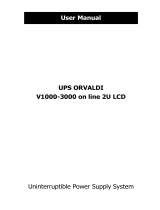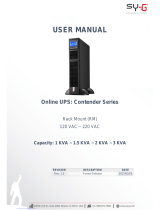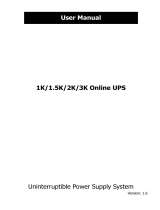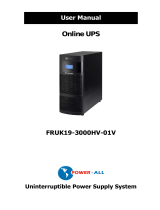Page is loading ...


1
www.powershield.com.au
Introduction
Thank you for choosing PowerShield.
PowerShield Centurion RT UPS series are designed to provide the highest level of protection
against disturbances found on electrical power supply lines. It is suitable for most applications
including IT, security, telephone, broadcasting, medical etc.
The Centurion RT UPS series are designed to provide the most comprehensive protection for
your valuable electronic equipment, hardware, software and data from harmful disturbances
found on AC power lines including blackouts, power sags, power surges, under voltage, over
voltage, line noise, frequency variation, switching transients and harmonic distortions. The
Centurion RTs true online double conversion topology will continuously protect your equipment
by internally isolating your equipment from the utility power ensuring that all your equipment
always receives clean, uninterrupted and stable power.
Very Important !! : WARRANTY REGISTRATION
In order to validate product warranty, it is essential that you register your UPS on line.
Please Visit PowerShield on line product warranty web page at
www.powershield.com.au/register-products/
This user manual contains instructions relating to safety, installation, operation, maintenance
and warranty of this product.
Please keep this manual in a safe place for future references.

2
www.powershield.com.au
Special Symbols
The following symbols are used on the UPS to alert you to important information.
RISK OF ELECTRIC SHOCK -
Indicates that a risk of electric shock is present and the associated
warning should be observed
CAUTION; REFER TO OPERATOR’S MANUAL -
Refer to your operator’s manual for additional information, such as
important operating and maintenance procedures.
SAFETY EARTHING TERMINAL -
Indicates the primary safety ground.
This symbol indicates that you should not discard the UPS or the UPS
batteries in the trash. The UPS may contain sealed, lead-acid
batteries. Batteries must be recycled.

3
www.powershield.com.au
Table of Contents
1. Important Safety Warning ......................................................................... 4
1-1. Transportation ................................................................................... 4
1-2. Preparation ....................................................................................... 4
1-3. Installation ........................................................................................ 4
1-4. Operation .......................................................................................... 5
1-5. Maintenance, service and faults .......................................................... 5
2. Installation and setup ............................................................................... 6
2-1 Rear panel view .................................................................................. 6
2-2. Installing the UPS .............................................................................. 7
2-3. Setting up the UPS............................................................................. 8
2-4 Battery Replacement .......................................................................... 11
2-5 Battery Kit Assembly (option) ............................................................. 12
3. Operations .............................................................................................. 13
3-1. Button operation ............................................................................... 13
3-2. LCD Panel ........................................................................................ 14
3-3. Audible Alarm ................................................................................... 15
3-4. LCD display wordings index ............................................................... 15
3-5. UPS Parameter Settings .................................................................... 16
3-6. Operating Mode Description .............................................................. 20
3-7. Faults Reference Code ....................................................................... 21
3-8. Warning indicator ............................................................................. 21
4. Troubleshooting ...................................................................................... 22
5. Storage and Maintenance ........................................................................ 23
5-1. Operation ......................................................................................... 23
5-2. Storage ............................................................................................ 23
6. Specifications .......................................................................................... 24

4
www.powershield.com.au
1. Important Safety Warning
For safety reasons, it is essential to comply with all warnings and operating instructions listed
in this manual. Do not operate the UPS unit before carefully reading through all safety
information and operating instructions. It is recommended that you save and or backup this
manual for future reference.
1-1. Transportation
Transport the UPS system using only the original packaging to protect against shock
and impact.
Handling Safety
Do not lift heavy loads without assistance.
This equipment is intended for installation in a controlled temperature indoor area free
from conductive contaminants.
1-2. Preparation
The UPS system must be absolutely dry before installation. As condensation may
occur if the UPS system is moved directly from cold to warm environments, allow at
least two hours for the UPS system to acclimate to the environment.
Do not install the UPS system near water or in moist environments.
Do not install the UPS system where it would be exposed to direct sunlight or near
heaters.
Do not block ventilation holes in the UPS housing.
1-3. Installation
Do not connect appliances or devices that may overload the UPS system (e.g. laser
printers) to the UPS output sockets.
To ensure against physical hazards, place cables safely such that persons cannot
accidentally trip over or step on them.
Do not connect domestic appliances such as hair dryers to UPS output sockets.
The UPS can be operated by any individual without previous experience.
Always connect the UPS system to an earthed shockproof outlet that is easily
accessible and close to the UPS system.
Use only VDE-tested, CE-marked mains cable (e.g. the mains cable of your computer)
to connect the UPS system to the building wiring outlet (shockproof outlet).
Use only VDE-tested, CE-marked power cables to connect the loads to the UPS
system.
When installing the equipment, ensure that the sum of the leakage currents of the
UPS and the connected devices do not exceed 3.5mA.

5
www.powershield.com.au
1-4. Operation
Do not disconnect the mains cable on the UPS system or the building wiring outlet
(shockproof socket outlet) during operations as this will cancel and invalidate the
protective earth of the UPS system and of all connected loads.
As the UPS system features its own internal current source (high capacity batteries),
the UPS output sockets may be electrically live even if the UPS system is not
connected to the building wiring outlet.
In order to fully disconnect the UPS system, first press the OFF/Enter button to
disconnect the mains.
Prevent fluids or other foreign objects from entering inside the UPS system.
1-5. Maintenance, service and faults
The UPS system operates with hazardous voltages. Repairs should only be carried out
by qualified maintenance personnel.
Caution - risk of electric shock. Even after the unit is disconnected from the mains,
building wiring outlet, components inside the UPS system are still connected to the
battery and electrically live and dangerous.
Before carrying out any kind of service and/or maintenance; switch off mains power,
then disconnect the batteries and verify that no hazardous voltages are present at the
terminals of the large storage capacitors (the BUS-capacitors).
Only persons who are adequately familiar with high capacity batteries, and with the
understanding of the required precautionary measures outlined below, are permitted
to replace batteries and supervise operations. Unauthorized persons must be kept
well away from the batteries.
Caution - risk of electric shock. The battery circuit is not isolated from the input
voltage. Hazardous voltages may occur between the battery terminals and the
ground. Before touching, always verify that no voltage is present!
Batteries may cause electric shock and have very high short-circuit currents. When
working with batteries always ensure the following precautionary measures are
adhered to:
-remove all jewellery items (wristwatches, rings and metal objects)
-use only tools with insulated grips and handles.
When changing batteries, always install the same model and type of batteries.
Do not attempt to dispose of batteries by burning as they may explode.
Do not open or destroy batteries. Escaping electrolyte can cause injury to the skin
and eyes and may be toxic.
Replacement fuses must be of the same type and amperage (current rating) in order
to avoid fire hazards.
Do not dismantle the UPS system.

6
www.powershield.com.au
2. Installation and setup
NOTE: Inspect the unit before installation for any evidence of mistreatment or damage of
contents inside the packaging during transport. Store the original package in a safe place for
future use.
NOTE: There are two different types of online UPS: standard and long-run models. Please
refer to the following model table.
Model No.
Type
Model No.
Type
PSCERT1000
Standard
PSCERT1000L
Long-run
PSCERT2000
PSCERT2000L
PSCERT3000
PSCERT3000L
2-1 Rear panel view
AC Input - 10Amp IEC AC Input - 10Amp IEC
PSCERT1000(L)
PSCERT2000
AC Input - 15 Amp IEC
PSCERT3000(L)
AC Input - 15 Amp IEC
PSCERT2000L
1. Programmable outlets: connect to non-critical loads.
2. Output receptacles: connect to mission-critical loads.
3. AC input
4. Emergency power off function connector (EPO)
5. USB communication port
6. RS-232 communication port
7. SNMP intelligent slot
8. External battery connector

7
www.powershield.com.au
2-2. Installing the UPS
The UPS is usually shipped from the factory with the battery wires connected. Note: LCD and
alarm will indicate if battery wires are not connected at the start of power up sequence. If not
connected, follow the steps below to re-connect the battery wires.
Step 1
Step 2
Step 3
Remove front panel.
Battery wires are connected behind
metal plate. Connect the AC input.
Replace front panel on the
unit.
This UPS can be used as either a stand-alone tower or rack mounted in a 19” chassis. Choose
from the appropriate installation instructions below to position the UPS accordingly.
Rack-mount Installation
Install UPS alone
Install UPS and external battery
Contact www.powershield.com.au on 1300-305-393 for optional PowerShield Rail Kit - PSRK
battery wires behind
metal plate

8
www.powershield.com.au
Tower Installation
Step 1
Step 2
Step 3
Install UPS and external battery
2-3. Setting up the UPS
Step 1: UPS input connection
When connecting the UPS to the mains supply always use a three pin plug, three-wire,
grounded receptacle and avoid using extension cords.
Step 2: UPS output connection
There are two kinds of socket-type outputs: programmable outlets (white coloured outlets)
and general outlets (black coloured outlets). Connect non-critical devices to the programmable
outlets and critical devices to the general outlets. The backup time to critical devices may be
extended during power failure by setting shorter backup time for non-critical devices.
Step 3: Communication connection
Communication port:
USB port RS-232 port Intelligent slot
To allow for unattended UPS shutdown/start-up and status monitoring, connect the
communication cable on one end to the USB or RS-232 port of the UPS and the other to the
USB or RS232 communication port of your PC. With the monitoring software installed, you can

9
www.powershield.com.au
schedule UPS shutdown/start-up and monitor UPS status through the PC.
The UPS is equipped with an intelligent slot to accommodate either an SNMP or AS400 card.
When installed, either the SNMP or AS400 card will provide advanced communication and
monitoring options for the UPS.
Please Note: The USB port and RS-232 port can NOT operate at the same time.
Step 4: Disable and enable EPO function
For normal UPS operation, connect pin 1 and pin 2 (closed switch). To activate Emergency
Power Off (EPO) function, cut the wire between pin 1 and pin 2 (open switch).
Step 5: External Battery Bank connection
Connect the UPS to the first Battery Bank and daisy chain any additional Battery Banks in
parallel using the external battery cables provided.
BATTERY BANKS
PSRTBB6 suits PSCERT1000(L)
PSRTBB12 suits PSCERT2000(L) and PSCERT3000(L)
Illustration is in the closed switch
position for normal UPS operation.
UPS
External battery cable
External battery cable
Battery Bank
Battery Bank

10
www.powershield.com.au
Step 6: Turn on the UPS
Press the ON/Mute button on the front panel for two seconds to power on the UPS.
Note: The battery will fully charge during the first five hours of normal operation. Do not
expect full battery run capability during this initial charge period.
Step 7: Software Installation
For optimal computer system protection, install the UPS monitoring software to fully configure
UPS shutdown.
Follow the steps below to download and install NetGuard monitoring software:
1. Go to the website www.powershield.com.au
2. Click Downloads software icon and choose your required OS to download the NetGuard
software in the http://www.powershield.com.au/downloads/ downloads page.
3. Follow the on-screen instructions to install the NetGuard software.
4. When the computer re-starts, the NetGuard monitoring software will appear as an orange
plug icon located in the system tray, near the clock.

11
www.powershield.com.au
2-4 Battery Replacement
NOTICE: The UPS is equipped with a hot-swappable battery design so the internal batteries
can be replaced without shutting down the UPS or connected loads. Replacement is a safe
procedure, isolated from electrical hazards.
CAUTION!! Consider all warnings, cautions and notes before replacing batteries.
Note: The equipment is not protected from power outages during battery disconnection.
Step 1
Step 2
Step 3
Remove front panel.
Remove the screws on front
plate and remove plate.
Disconnect battery wires.
Pull out the battery box.
Step 4
Step 5
Step 6
Remove the top cover of
battery box and replace the
batteries inside.
Slide the battery box back in
the original location,
re-connect the battery wires
and fasten the screws on
metal cover securely.
Replace front panel.
Step 7
Replace the front panel on the unit.
battery wires behind front plate
battery wires behind metal plate

12
www.powershield.com.au
2-5 Battery Kit Assembly (option)
Call Service on 1300-305-393 or contact www.powershield.com.au for fully assembled
replacement battery kits.
Alternatively, follow the procedures below to assemble new battery kits before replacing used
UPS batteries kits.
3-battery kit
Step 1: Remove adhesive tapes.
Step 2: Connect all battery terminals by
following below chart.
Step 3: Put assembled battery packs on
one side of plastic shells and insert one
more defect battery on the space.
Step 4: Cover the other side of plastic shell as
below chart. Then, battery kit is assembly well.
6-battery kit
Step 1: Remove adhesive tapes.
Step 2: Connect all battery terminals by
following the chart below.
Step 3: Place assembled battery packs on
one side of the plastic shells.
Step 4: Cover the other side of the plastic shell
as shown below so that the battery kit assembly
is ready for installation.
Tapes
Tapes
Tapes
Tapes
Defect
battery

13
www.powershield.com.au
3. Operations
3-1. Button operation
Button View
Button
Function
ON/Mute Button
Turn on the UPS: Press and hold ON/Mute button for at least 2
seconds to turn on the UPS.
Mute the alarm: After the UPS is turned on in battery mode, press
and hold this button for at least 3 seconds to disable or enable the
alarm system. This does not mute other warnings or errors.
Up key: Press this button to display previous selection in UPS setting
mode.
Switch to UPS self-test mode: Press ON/Mute buttons for 3 seconds
to enter UPS self-testing while in AC mode, ECO mode, or converter
mode.
OFF/Enter Button
Turn off the UPS: Press and hold this button for at least 2 seconds to
turn off the UPS. UPS will switch off to standby mode under normal
power or transfer to Bypass mode if the Bypass setting has been
enabled.
Confirm selection key: Press this button to confirm selection in UPS
setting mode.
Select Button
Switch LCD message: Press this button to change the LCD message
for input voltage, input frequency, battery voltage, output voltage
and output frequency.
Setting mode: Press and hold this button for 3 seconds to enter UPS
setting mode when in Standby or Bypass mode.
Down key: Press this button to display next selection in UPS setting
mode.
ON/Mute + Select
Button
Switch to bypass mode: When the main power is normal, press
ON/Mute and Select buttons simultaneously for 3 seconds. Then UPS
will enter bypass mode. This action will be ineffective when the input
voltage is out of acceptable range.
Exit setting mode or return to the upper menu: When working in
setting mode, press ON/Mute and Select buttons simultaneously to
return to the upper menu. If it’s already in top menu, press these two
buttons at the same time to exit the setting mode.

14
www.powershield.com.au
3-2. LCD Panel
Display
Function
Indicates the remaining backup time in numbers or digits.
HRS: hours, MIN: minutes, SEC: seconds
Warning & Fault information
Indicates that a warning and fault occurs.
Indicates the warning and fault codes as listed in detail in
section 3-7 and 3-8.
Setting Operation
Indicates the setting operation.
Battery, Input, Temperature, Output and Load information
Indicates the input voltage, input frequency, battery voltage,
battery capacity and ambient temperature.
k: kilo, W: watt, V: voltage, A: ampere, %: percent, ℃: centigrade degree, Hz:
frequency, AC: alternating current, DC: direct current
Indicate the output voltage, output frequency, load current
and load percentage.
k: kilo, W: watt, V: voltage, A: ampere, %: percent, Hz: frequency, AC:
alternating current
Load information
Indicates the load level by 0-24%, 25-49%, 50-74%, and
75-100%.
Indicates overload.
UPS status
Indicates that programmable management outlets are
working.
Indicates the UPS alarm is disabled.
Indicates the UPS is working in bypass mode.
Indicates the UPS powers the output directly from the mains
Indicates the UPS connects to the mains.
Indicates the UPS connects to the PV
Indicates the AC to DC circuit is working
Indicates the inverter circuit is working
Battery information
Indicates the Battery level by 0-24%, 25-49%, 50-74%, and
75-100%.

15
www.powershield.com.au
3-3. Audible Alarm
Battery Mode
2 beeps every 30 seconds
Bypass Mode
1 beep every 10 seconds
Low Battery
Rapid one beep every second
Overload
2 short beeps every 2 seconds
Fault
Continuously sounding
3-4. LCD display wordings index
Abbreviation
Display content
Meaning
ENA
Enable
DIS
Disable
CF
Constant Frequency Constant Voltage
BAT
Battery
HLS
High loss
LLS
Low loss
BAH
Battery AH
CHA
Charger current
CBV
Charger boost voltage
CBF
Charger float voltage
AUT
Automatic
AON
Always on
ESC
Escape
ON
ON
OK
OK
EP
EPO
TP
Temperature
CH
Charger
BF
Battery Fault
FU
Bypass frequency unstable
BR
Battery Replace
EE
EEPROM error

16
www.powershield.com.au
3-5. UPS Parameter Settings
Parameter 2 Parameter 3 Parameter 1
There are three parameters to set up the UPS.
Parameter 1: It’s for program alternatives. Refer to
below table.
Parameter 2&3: It’s is the setting options or values
for program.
01: Output voltage setting
Interface
Setting
For 200/208/220/230/240 VAC models, you may choose the
following output voltage:
200: sets output voltage to 200Vac
208: sets output voltage to 208Vac
220: sets output voltage to 220Vac
230: sets output voltage to 230Vac
240: sets output voltage to 240Vac (Default setting)
02: Frequency Converter enable/disable
Interface
Setting
CF ENA: converter mode enable
CF DIS: converter mode disable (Default setting)
03: Output frequency setting
Interface
Setting
The frequency may be set in battery mode:
BAT 50: sets output frequency to 50Hz
BAT 60: sets output frequency to 60Hz
If converter mode is enabled, output frequency can be selected:
CF 50: sets output frequency to 50Hz
CF 60: sets output frequency to 60Hz
04: ECO enable/disable
Interface
Setting
ENA: ECO mode enable
DIS: ECO mode disable (Default setting)

17
www.powershield.com.au
05: ECO voltage range setting
Interface
Setting
Parameter 1 & 2: Set the acceptable high voltage point and low
voltage point for ECO mode by pressing Down key or Up key.
HS: High loss voltage in ECO mode in parameter 2.
The setting range in parameter 3 is from +7V to +24V of the
nominal voltage. (Default: +12V)
LS: Low loss voltage in ECO mode in parameter 2.
The setting range in parameter 3 is from -7V to -24V of the
nominal voltage.
(Default: -12V)
06: Bypass enable/disable when UPS is off
Interface
Setting
Parameter 2: Enable or disable Bypass function. You may choose
the following two options:
ENA: Bypass enable
DIS: Bypass disable (Default setting)
07: Bypass voltage range setting
Interface
Setting
Parameter 1 & 2: Set the acceptable high voltage point and
acceptable low voltage point for Bypass mode by pressing the
Down key or Up key.
HS: Bypass high voltage point
230-264: setting the high voltage point in parameter 3 from
230Vac to 264Vac. (Default: 264Vac)
LS: Bypass low voltage point
170-220: setting the low voltage point in parameter 3 from
170Vac to 220Vac (Default: 170Vac)
08: Bypass frequency range setting
Interface
Setting
Parameter 1 & 2:Set the acceptable high frequency point and
acceptable low frequency point for Bypass mode by pressing the
Down key or Up key.
HS: Bypass high frequency point
For 50Hz output frequency models:
51-55Hz: setting the frequency low loss point from 51Hz to
55HZ(Default: 53.0Hz)
For 60Hz output frequency models:
61-65Hz: setting the frequency low loss point from 61Hz to
65Hz(Default: 63.0Hz)
LS: Bypass low Frequency point
For 50Hz output frequency models:

18
www.powershield.com.au
45-49Hz: setting the frequency low loss point from 45Hz to
49HZ(Default: 47.0Hz)
For 60Hz output frequency models:
55-59Hz: setting the frequency low loss point from 55Hz to
59Hz(Default: 57.0Hz)
09: Programmable outlets enable/disable
Interface
Setting
Parameter 2: Enable or disable programmable outlets.
ENA: Programmable outlets enable
DIS: Programmable outlets disable (Default setting)
10: Programmable outlets setting
Interface
Setting
Parameter 2: Set up backup time limits for programmable outlets.
0-999: setting the backup time limits in minutes from 0-999 for
programmable outlets which connect to non-critical devices on
battery mode. (Default: 999)
11: Autonomy limitation setting
Interface
Setting
Parameter 2: Set up backup time on battery mode for general
outlets.
0-999: setting the backup time in minutes from 0-999 for general
outlets on battery mode.
DIS: Disable the autonomy limitation and the backup time will
depend on battery capacity. (Default)
Note: When setting as “0”, the backup time will be only 10
seconds.
12: Battery total AH setting
Interface
Setting
Parameter 2: Set up the battery total AH of the UPS.
7-999: setting the battery total capacity from 7-999 in AH. Please
set the correct battery total capacity if external battery bank is
connected.
13: Charger maximum current setting
Interface
Setting
Parameter 2: Set up the charger maximum current.
1/2/4/6/8: setting the charger maximum current 1/2/4/6/8 in
Ampere. (Default: 8A)
Note: the setting is only effective for super charger

19
www.powershield.com.au
14: Charger Boost voltage setting
Interface
Setting
Parameter 2: Set up the charger boost voltage.
2.25-2.40: setting the charger boost voltage from 2.25 to
2.40(unit: 1V/cell). (Default: 2.36)
15: Charger Float voltage setting
Interface
Setting
Parameter 2: Set up the charger float voltage.
2.20-2.33: setting the charger float voltage from 2.20 to
2.33(unit: 1V/cell). (Default:2.28)
16: LCD display backlight setting
Interface
Setting
Aon: LCD display backlight is on all the time.
Aut: LCD display backlight will turn off after 60 seconds if no
buttons are pressed. (Default setting)
00: Exit setting
Interface
Setting
Exit the setting mode.
3-5-1 Steps for setting programmable outlet ( White Coloured Outlets )
Step 1: Before entering setting mode, ensure the UPS is in either
Bypass or Stand-by mode (off-charging) and make sure the battery is
connected. The LCD display is shown at right.
Step 2: Press and hold the “Select” button for 3 seconds to enter
Setting mode.
/




